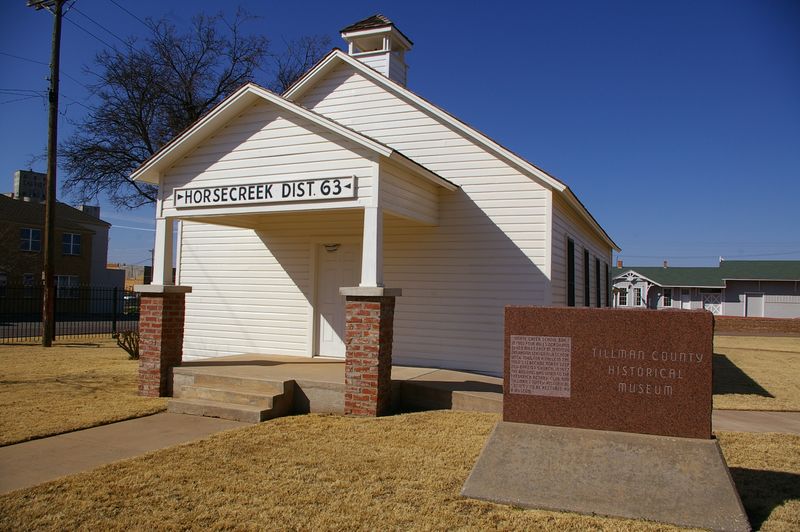U.S. 183 generally follows a path taken by cattle drovers that passed through the Wichita Mountains and continued north through Clinton, Woodward and Buffalo, terminating at Kansas railheads. The Great Western Trail, known alternatively as the Texas Trail and several other names, has a sense of endless earth, with long stretches uninterrupted by anything made by man. I pick up the trail in Frederick after spending the night at the nearby Lazy S Ranch.
Lazy S Ranch
Some of the land that makes up the sprawling Lazy S Ranch has been in Kirk Schreiner’s family for generations. The rest of it he bought or leased in sections, building a ranch with thousands of acres that he uses to raise cattle and grow hay, alfalfa and wheat. The last piece of the puzzle was a ranch house on two acres surrounded by Schreiner’s property. The once private residence is now available for guests who come to hunt, taste ranch life or simply get a little distance from city life.
Pioneer Heritage Townsite Center
There’s plenty of history at the Pioneer Heritage Townsite, a collection of 1920s-era buildings that covers more than a city block. But the newest exhibit is my favorite, as it’s all about Frederick’s most famous duo, the Abernathy boys. Louis Abernathy and his brother, Temple, were adventurers of the first order. From Frederick, they rode their horses to New York to see their hero, President Teddy Roosevelt. They returned to Frederick driving their own Brush automobile. What made those and their other adventures astonishing were their ages – the boys were 6 and 10 at the time.
Dodging Mountains
Cattle drovers did their best to avoid obstacles en route, as rivers, mountains and lakes all meant delays in getting the cattle to market. In southwest Oklahoma, I’m reminded that road builders had good reason to follow established cattle trails. At Snyder, the Wichita Mountains pop up out of the prairie almost at random, with apparently vertical facades spartanly dotted with the hardiest of trees. The mesas here could have easily found their way into a John Ford film. Have a camera at hand.
The Local Lore
Housed in the former Rock Island railroad depot at Hobart, the Kiowa County Historical Museum is laden with local history. Most of the artifacts came from area families and include dentistry and ophthalmology equipment, horse-drawn wagons, covered wagons, hearses, firearms, automobiles and cowboy gear. I enjoy the extensive collection of bits and appreciate curator Ted Block’s knowledge of their names and uses. After all, not everyone knows what a double twisted wire jointed snaffle is.
Time for a Pig Sickle
My lunch plans lead me to Jigg’s Smokehouse in Clinton, where I sample everything on the menu. Really. This is hole-in-the-wall food in the best possible way. It smelled great when I walked in, and it has true roadside character – my business card has joined the hundreds of others adorning the wall. The food came on a piece of paper with plastic utensils, and every bite was delicious. The Pig Sickle, a boneless pork rib patty, tastes great with the house sauce. The made-right-there jerky is terrific. But the smoked brisket sandwich spilling out of a five-inch bun with a side of chow chow relish truly tantalizes.
County Culture
On the way from Hobart to Clinton, I stop in Cordell to check out the Washita County Museum. Housed in a Carnegie Library built in 1911, the museum has a collection that includes a chuck wagon of the sort that would have been used along the cattle trails. Be alert if you want to visit – the museum is open only from 2 to 4 p.m. Fridays or by appointment. While you’re there, tour the county courthouse, which is a block away – it has more character than several of my relatives.
North, Where the Wind Comes Sweeping
I stick with U.S. 183 to Woodward, but instead of continuing along the Great Western Trail to Buffalo, I take a detour into the panhandle to see the spot where the Santa Fe Trail crossed through Oklahoma. The drive into Woodward from the south is interesting because the terrain changes from flat prairie to rolling hills. It goes back to prairie in rather dramatic fashion on the drive from Woodward to Guymon. I pass through Woodward before dark, so I get to see one of the huge wind farms in that area, just north of the city. There are 34 turbines, each 210 feet tall; it’s really a sight.
Hoot Owl Ranch
It’s nearly 11:30 p.m. when I arrive at the Hoot Owl Ranch near Kenton, where I’m bunking for the night in one of two modern guest cabins. The main residence and barn were built of sandstone in the 1880s, about 20 years after “Captain” William Coe’s gang inhabited Robber’s Roost on the nearby Black Mesa.
Sante Fe Trail
Retracing my route through Boise City and east toward Guymon, I stop at the historical markers for the Santa Fe Trail and Fort Nichols. Every once in a while, I’m mesmerized by those roadside signs. I already knew about the Santa Fe Trail – it was the trade trail that connected Santa Fe, New Mexico and Kansas City, Missouri, catching just a corner of Oklahoma along the way. But I’m surprised to read that the legendary frontiersman Kit Carson established Fort Nichols – also known as Camp Nichols and Camp Nichols Ranch – as the only man-made structure on the Cimarron Cutoff of the Santa Fe Trail. It was there to protect commerce on the trail from Kiowa and Comanche raids. The building’s ruins are on private property.

















